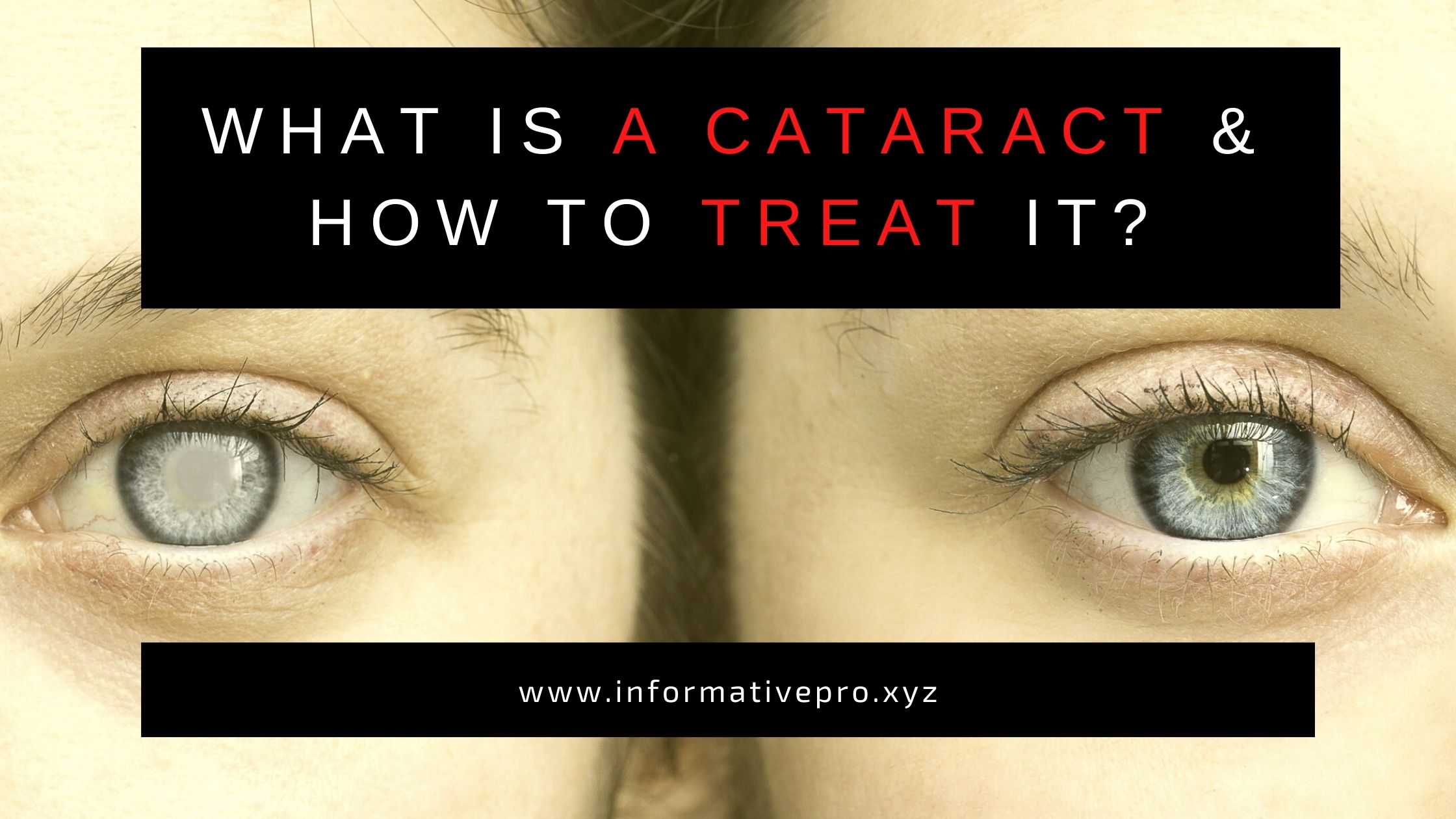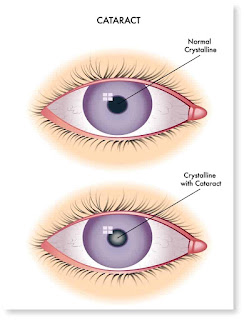
CATARACT
What is a cataract?
A cataract is a cloudy area that is formed in the lens of the
eyes.
Cataracts are very common as you get older. It generally occurs
when proteins in the eye form clumps that prevent the lens from sending clear
images to the retina.
Cataract surgery is the most common and one of the safest ways to
correct the vision problems caused by cataracts.
What are the types of Cataracts?
1. Nuclear
cataracts:
- They affect
the center of the lens. In this condition, first, you may experience more
near-sightedness or even a temporary improvement in your reading vision.
But gradually as time passes, the
lens gradually turns more densely yellow and it further clouds your vision.
2. Cortical
cataracts:
- They affect
the edges of the lens. It occurs as white wedges or streaks on the outer
edge of the lens cortex.
3. Posterior
subcapsular cataracts:
- They
affect the back of the lens. It forms the opaque area near the back of the
lens.
You might experience interferes with
your reading vision, reduced vision in bright light, and glare or halos around
the lights at night.
4. Congenital
cataracts:
- These are developed during childhood
during birth. The reason for its cause is associated with genetics or some
injury as well.
What are the symptoms of Cataracts?
While cataracts grow, they can cause changes in your vision.
Some noticeable changes caused by them are:
- Cloudy
or Blurry Vision - Colors
look faded - Increasing
difficulty with vision at night - Seeing
“halos” around lights - Lamps,
sunlight, or headlights seem too bright - Double
vision in a single eye - Sensitivity
to light and glare - Need
for brighter light for reading and other activities - Frequent
changes in eyeglass or contact lens prescription
Are you at Risk for Cataracts?
There is a higher risk of developing cataracts if you have the
problems mentioned below.
- Health
problems such as diabetes - High blood pressure
- Obesity
- Previous
eye surgery - Family
history of cataracts - Prolonged
use of corticosteroid medications - Smoking
- Consumption
of excessive alcohol - Excessive
exposure to sunlight - Increasing
age
What
are the causes of Cataracts?
There are several reasons for
developing cataracts:
·
The long-term use of steroids
·
Smoking
·
Ultraviolet radiation
·
Trauma
·
Radiation therapy
·
Diabetes
How
Cataract can be prevented?
There are certain steps that you
should take to protect your eyes and to delay cataracts:
·
Use sunglasses and a hat to block the
sun
·
Quit smoking
·
Eat Healthily: Adding powerful
antioxidants to your diet can improve your eye health.
·
Get a dilated eye exam
·
Reduce the use of alcohol
What
are foods rich in antioxidants that are good for eye health?
Following vitamins and nutrients are
listed as follows for good eye health:
1. Vitamin C:
Vitamin C lowers the risk of developing cataracts.
It is found in:
·
Oranges
·
Grapefruit
·
Strawberries
·
Papaya
·
Green peppers
·
Tomatoes
2. Lutein & Zeaxanthin:
Lutein and zeaxanthin lower the risk of developing new
cataracts.
Foods
including lutein and zeaxanthin are:
·
Broccoli
·
Corn
·
Persimmons
·
Peas
·
Tangerines
3. Vitamin E:
Vitamin E protects eye cells from unstable molecules called free
radicals that break down healthy tissue.
Food sources of Vitamin E are:
·
Safflower and corn oil
·
Nuts
·
Wheat germ
·
Sweet potatoes
4. Essential
fatty acids:
It helps in visual development and
retinal development. They include:
- Salmon
- Tuna
- Cold-water
fish
Diagnosis
for Cataract
Checking
Cataracts
An eye doctor performs a dilated eye
exam that is extremely simple and painless. In this test, a doctor puts
some eye drops to widen the pupil and then tests for the cataract.
What
are the treatments for Cataracts?
1. Treatment at Home:
In the early stage of cataract you can do a few things to manage
cataracts:
·Use bright lights at home
·Use magnifying lenses for reading
·Wear anti-glare sunglasses
2. New glasses:
A new prescription for eyeglasses or contact lenses can help you
see better with cataracts early on.
3. Surgery:
Your doctor might recommend surgery if you are not able to
perform daily activities such as reading, driving, watching TV, etc.
Cataract surgery is one of the safest
and most effective types of surgery performed. About 9 out of 10 people who get
it can see better afterward.
Types
of Cataract Surgery
1. Phacoemulsification:
In this surgery, ultrasound waves are used to break the lens
apart and remove the pieces.
2. Extracapsular surgery:
In this
surgery, the cloudy part of the lens is removed through a long incision in the
cornea. Then an artificial intraocular lens is placed in the place of the
natural lens.
If you are not interested in surgery,
the doctor might suggest stronger eyeglasses, magnifying lenses, or sunglasses
with an anti-glare coating to deal with your symptoms of cataract.
Outlook
You should consult an eye doctor to
talk about various options to deal with the condition of cataract. Your eye
doctor will brief you about the benefits and risks of cataract surgery.
FREQUENTLY
ASKED QUESTIONS:
Q1. What activities should be avoided
after cataract surgery?
- You should avoid performing exercise, strenuous activities, driving, and
heavy lifting. Your eye needs to heal after surgery so you should give some
time for it to do the same.
Q2. What food is good after cataract
surgery?
- You should include foods that are
rich in fiber, green leafy vegetables, lean protein in your diet.
Q3. How long do you need to wear dark
glasses after cataract surgery?
- Doctors generally recommend wearing
post-cataract surgery sunglasses for about the first month of the recovery
stage.
Q4. How long does a cataract operation
take?
- Although it depends on your eye
doctor usually the procedure takes about 15-45 minutes of time to finish.
Q5. How long does it take for blurriness
to go away after cataract surgery?
- You would be able to see improvement
within 24-48 hours after cataract laser surgery, although it can take up to two
weeks for your eyes to fully adjust to the new implants.
Q6. Do cataracts grow back?
- No, cataracts cannot grow back.
Q7. At what ages do you usually get
cataracts?
- In most people, cataracts start
developing around age 60.






Leave a Reply